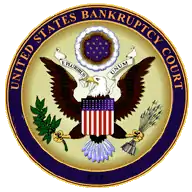Chapter 12, Title 11, United States Code
Chapter 12 of Title 11 of the United States Code, or simply chapter 12, is a chapter of the Bankruptcy Code. It is similar to Chapter 13 in structure, but it offers additional benefits to farmers and fishermen in certain circumstances, beyond those available to ordinary wage earners. Chapter 12 is applicable only to family farmers and fishermen.
| Bankruptcy in the United States |
|---|
 |
| Bankruptcy in the United States |
| Chapters |
| Aspects of bankruptcy law |
History
Background
For much of the history of bankruptcy law in the United States, there was no provision applicable specifically to farmers. The 1898 Bankruptcy Act contained no special provisions, with one exception that farmers were immune from an involuntary bankruptcy petition. Section 75 was enacted by the Bankruptcy Act of 1933 and provided specific provisions for farmers.[1] However, many of these provisions were limited in scope, and ultimately required the voluntary cooperation of mortgagors and creditors.
In addition, section 75, as it was originally conceived, was a temporary measure. It was scheduled to expire on March 3, 1938.[1]
The Frazier-Lemke Act expanded the scope of section 75, providing for stronger protections available to farmers operating under bankruptcy protection. These changes too were initially temporary, but they were extended a number of times until they ultimately expired on March 31, 1949.[1]
By and large, after the expiration of section 75, farmers were subject to the same rules of bankruptcy as other debtors. The application of the same rules was the case after the passage of the Bankruptcy Code of 1976 until 1986.[1]
Passage
Chapter 12 was added to the Bankruptcy Code in 1986 by the Bankruptcy Judges, United States Trustees, and Family Farmer Bankruptcy Act of 1986.[2][3] It went into effect on November 26, 1986.[2]
The modification of the bankruptcy code were intended as an emergency response to tightening agricultural credit in the early and mid-1980s, in the middle of a number of notable bank failures.[1]
The Act was to originally expire on October 1, 1993, but it was extended a number of times without expiring until it was made permanent by the 2005 BAPCPA.[1]
Description
Chapter 12 provides additional benefits not available under chapter 13 and chapter 11. These benefits include higher debt ceilings than those under chapter 13, and more advantageous exemptions.
References